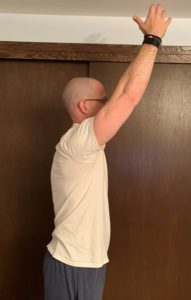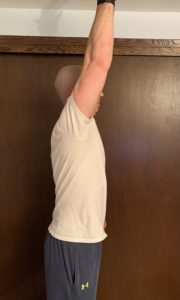The shoulder is a complex area as there are multiple joints that all need to work together for optimal function. However, when most people talk about the “shoulder joint” they are referring to the glenohumeral joint.
This joint, when functioning well, allows the shoulder to move in multiple planes of motion. Muscles of course help with this and a huge stabilizing force is the rotator cuff (see below for more). Additional joints that aid in overall upper quadrant mobility include the acromioclavicular, sternoclavicular and scapulothoracic. If there is a lack of movement, or hypomobility, in one of these joints then the shoulder has to change its normal movement patterning and this ultimately can lead to breakdown at a neighboring joint. Posture also plays a huge role. Rounded shoulders can lead to impingement of the biceps tendon or rotator cuff. If you look at the schematic below, we can see that with more optimal posture we are able to reach overhead without any blocks. With rounded shoulders or poor posture we eventually will hit a block and when we do that repetitively overtime, well hopefully you can see how that would lead to irritation and shoulder pain.


The labrum is also an important part of the shoulder joint. The labrum is a piece of fibrocartilage that lines the socket part of the shoulder. The labrum is a huge stabilizer for the shoulder joint and it works closely with surrounding musculature to help in stability and proper function.
It would be odd not to touch on the rotator cuff when discussing the shoulder so lets do that now. The rotator cuff is made up of 4 muscles: supraspinatus, infraspinatus, subscapularis, teres minor.
These 4 muscles work together to help stabilize the joint and to help with motions such as reaching out to the side, behind the back and overhead. If there is breakdown (or a tear) in one of these muscles it can lead to instability at the shoulder joint as well as pain.
The shoulder is a complex area of the body and it is used all the time (imagine if you did not have function of your dominant arm for example). We need all these parts functioning well together in order for optimal use and participation in daily activities. If you feel like you have been ignoring any shoulder, neck or upper back pain please do not hesitate to reach out. As you’ve gotten to see through this blog, we need all parts functioning well together so one area may just need a little help from a trained Physical Therapist.